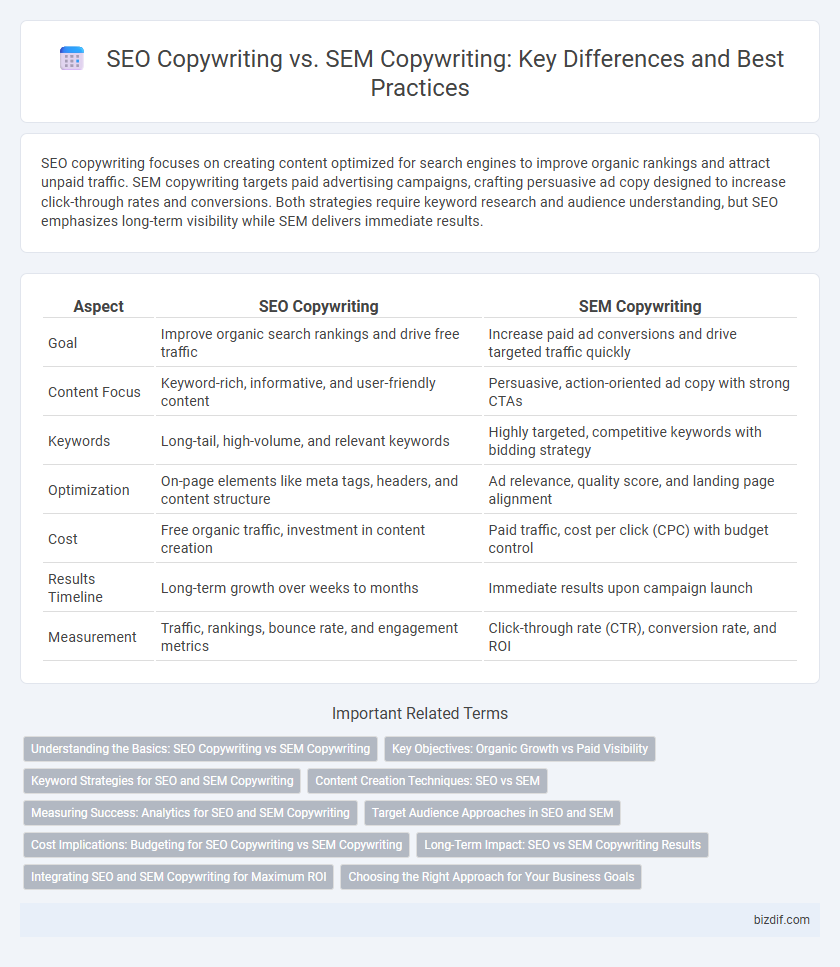SEO copywriting focuses on creating content optimized for search engines to improve organic rankings and attract unpaid traffic. SEM copywriting targets paid advertising campaigns, crafting persuasive ad copy designed to increase click-through rates and conversions. Both strategies require keyword research and audience understanding, but SEO emphasizes long-term visibility while SEM delivers immediate results.
Table of Comparison
| Aspect | SEO Copywriting | SEM Copywriting |
|---|---|---|
| Goal | Improve organic search rankings and drive free traffic | Increase paid ad conversions and drive targeted traffic quickly |
| Content Focus | Keyword-rich, informative, and user-friendly content | Persuasive, action-oriented ad copy with strong CTAs |
| Keywords | Long-tail, high-volume, and relevant keywords | Highly targeted, competitive keywords with bidding strategy |
| Optimization | On-page elements like meta tags, headers, and content structure | Ad relevance, quality score, and landing page alignment |
| Cost | Free organic traffic, investment in content creation | Paid traffic, cost per click (CPC) with budget control |
| Results Timeline | Long-term growth over weeks to months | Immediate results upon campaign launch |
| Measurement | Traffic, rankings, bounce rate, and engagement metrics | Click-through rate (CTR), conversion rate, and ROI |
Understanding the Basics: SEO Copywriting vs SEM Copywriting
SEO copywriting focuses on creating content optimized for organic search rankings by incorporating targeted keywords, quality backlinks, and user-friendly formatting to improve website visibility. SEM copywriting emphasizes paid advertising strategies, crafting compelling ad copy designed to increase click-through rates and conversions through platforms like Google Ads. Understanding the basics involves recognizing SEO aims for long-term, sustainable traffic growth, while SEM targets immediate visibility and quick results through paid campaigns.
Key Objectives: Organic Growth vs Paid Visibility
SEO copywriting aims to enhance organic growth by optimizing content with targeted keywords, improving search rankings, and driving long-term, sustainable traffic without direct costs. SEM copywriting focuses on paid visibility through compelling ad copy that increases click-through rates and immediate conversions within pay-per-click campaigns. Both strategies require tailored messaging that aligns with their distinct goals of attracting audience engagement either organically or via paid placements.
Keyword Strategies for SEO and SEM Copywriting
Keyword strategies for SEO copywriting emphasize long-tail, high-intent keywords integrated naturally into valuable content to boost organic search rankings and enhance user engagement. SEM copywriting focuses on targeted, high-conversion keywords optimized for paid campaigns, leveraging bid management and click-through rate data to maximize ROI. Both strategies require continuous keyword analysis and adaptation to align with evolving search algorithms and competitive bidding landscapes.
Content Creation Techniques: SEO vs SEM
SEO copywriting centers on integrating targeted keywords naturally within content to improve organic search rankings and user engagement, emphasizing long-form, informative articles and meta tag optimization. SEM copywriting focuses on crafting concise, compelling ad copy with strong calls-to-action designed to maximize click-through rates and conversions in paid search campaigns. Both techniques require audience analysis, but SEO leans towards content depth, while SEM prioritizes immediacy and persuasive messaging.
Measuring Success: Analytics for SEO and SEM Copywriting
Measuring success in SEO copywriting relies heavily on organic traffic metrics, keyword rankings, and user engagement statistics such as bounce rate and time on page to evaluate content effectiveness. SEM copywriting success is tracked through paid campaign analytics including click-through rates (CTR), cost per click (CPC), conversion rates, and return on ad spend (ROAS) to determine advertising impact. Integrating tools like Google Analytics and Google Ads provides comprehensive insights that help fine-tune both SEO and SEM copywriting strategies for improved performance.
Target Audience Approaches in SEO and SEM
SEO copywriting targets organic search users by optimizing content with relevant keywords, answering specific queries, and providing valuable information to improve search engine rankings. SEM copywriting focuses on attracting immediate clicks from paid ads by crafting compelling, action-oriented headlines and calls-to-action tailored to demographic and behavioral data. Understanding audience intent in SEO involves long-term engagement through informative content, while SEM relies on persuasive messaging for instant conversion.
Cost Implications: Budgeting for SEO Copywriting vs SEM Copywriting
SEO copywriting often requires a lower upfront investment, focusing on creating evergreen content that attracts organic traffic over time, resulting in cost efficiency for long-term campaigns. SEM copywriting involves higher immediate costs due to paid advertising expenses, including pay-per-click (PPC) fees, which demand continuous budget allocation to maintain visibility. Businesses must weigh the ongoing costs of SEM against the sustainable, albeit slower, return on investment offered by SEO copywriting when budgeting for digital marketing efforts.
Long-Term Impact: SEO vs SEM Copywriting Results
SEO copywriting drives long-term organic traffic by optimizing content for search engines and user intent, ensuring sustained visibility and consistent rankings over time. SEM copywriting delivers immediate results through paid campaigns, producing quick traffic spikes but requiring ongoing investment to maintain. While SEM offers rapid conversion opportunities, SEO fosters durability and cumulative growth, making it essential for long-term digital marketing strategies.
Integrating SEO and SEM Copywriting for Maximum ROI
Integrating SEO and SEM copywriting combines the strengths of organic keyword optimization with targeted paid advertising, driving both long-term traffic and immediate conversions. SEO copywriting enhances website authority and user engagement through relevant content, while SEM copywriting leverages compelling ad copy to boost click-through rates and ad quality scores. This synergy maximizes ROI by balancing sustainable search engine visibility with strategic paid campaign performance, optimizing budget allocation and increasing overall digital marketing effectiveness.
Choosing the Right Approach for Your Business Goals
SEO copywriting centers on crafting keyword-rich, valuable content that boosts organic search rankings and drives long-term traffic growth. SEM copywriting targets paid advertising campaigns, emphasizing compelling calls-to-action and high-conversion ad copy to deliver immediate visibility and results. Selecting the right approach depends on whether your business prioritizes sustained audience engagement through organic search or fast, targeted exposure via paid search marketing.
SEO Copywriting vs SEM Copywriting Infographic

 bizdif.com
bizdif.com